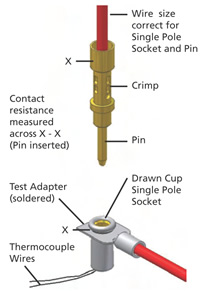* wire gauge was increased to carry current for taking data
Current Rating and Current Carrying Capacity


When an electric current passes through a connector interface, resistance heat is generated. The first passage of current across a newly mated connector where there is a defined interface resistance causes a minute local temperature rise and extremely small metal-to-metal “welds” to take place across the interface; this phenomenon is expected and results in an uninterrupted metal path across the interlace. As the current increases, the size of these minute welds increases up to a point, but in Single Pole Sockets and other separate connectors, they are still small enough to break apart on separation without visible impairment of the plating. As the current is increased more, further heating takes place not just in the plated films but in the pin and spring metal themselves. The heating, if significant and of long duration, can cause metallurgical deterioration of the finishes. This usually manifests itself by darkening of the luster of the finishes and is explained by migration of the metal atoms between plating and subplating and chemical activity with oxygen and certain air pollutants through ever present minute pores in the exterior plating.
It is sufficient to say that connector reliability can be jeopardized by long-term excessive current.
Cooling the connector takes place in two ways: by conducting the heat away via the electrical conductors and by conducting heat to the connector and conductor surfaces where circulating air carries it away by convection. The rate of cooling is affected by the size of the housing and conductors and by how much air circulates around the connector. In conducting the current rating tests, a drawn cup jack was used since it is low in mass and heats up more than any machined body jack with a given current.
The current rating is determined at CAMBION by first matching the pin size to the conductor size as follows:
| Up to | .025 (0,64) | dia. | 24 AWG |
| .030 (0.76) | | 20 AWG |
| .040(1,02) | | 20 AWG |
| .050(1,27) | | 16AWG |
| .062(1,57) | | 16 AWG |
| .080(2,03) | | 12 AWO |
| .094(2,39) | | 12 AWG |
Current Rating is defined as the current which produces one degree Centigrade increase in temperature under these conditions. Contact Resistance is measured at this current.
Maximum Current Carrying Capacity is defined as that current which produces a temperature rise of 30°C when the test is continued above the current rating.
These measurements are made with the Single Pole Socket soldered to insulated wires rather than mounted in printed circuit boards. In this way, variables of the mounting board heat dissipation are eliminated.
Cambion miniature pins and sockets are specifically designed for quick, tight, space-saving applications on printed circuits. All connectors are electrically and mechanically tested, carefully inspected for dimensional accuracy and, when necessary, subjected to severe environmental tests Cambion pins and sockets are available from stock in a wide range of sizes, materials and finishes to meet virtually every requirement.
Sockets are closed entry cage type. The loose piece socket consists of two pieces - a flexible spring and a housing. The spring formed from beryllium copper is hardened and then plated. Housings may be drawn copper cups or machined from brass depending on application. The spring is securely captivated in the housing by staking. Most loose piece socket connectors are offered with three plating finishes - gold spring and housing, gold spring and electro tin housing or electro-tin spring and housing. Loose piece sockets are available in many styles and sizes to accommodate miniature pins and wires in the range .014 (0,36) to .093 (2,36) diameter. For repeated usage, Cambion recommends that pins to mate with loose piece sockets should be within ± .002 (0,05) of nominal cage diameter.
Pins are precision engineered to be compatible with loose piece sockets and thereby provide positive and lasting electrical connections with low contact resistance. They are offered only gold plated, and pin diameters are held to ± .002 (0,05). Current carrying capacity and contact resistance for loose piece sockets mated with various pin diameters are shown in the following table
INSERTION / WITHDRAWAL FORCE DISTRIBUTION CURVES
Special requirements, for which there are no standard Cambion connectors, can be met with custom-designed pins and loose piece sockets.